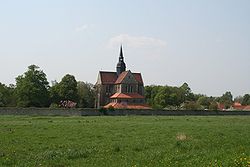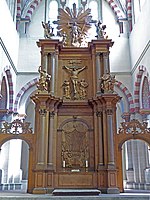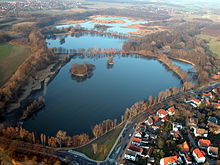Riddagshausen Monastery
| Riddagshausen Cistercian Abbey | |
|---|---|
 East side of the Riddagshausen monastery |
|
| location |
Lower Saxony Braunschweig |
| Coordinates: | 52 ° 16 '2.6 " N , 10 ° 34' 38.2" E |
| Serial number according to Janauschek |
209 |
| Patronage | St. Mary |
| founding year | 1145 |
| Year of dissolution / annulment |
1568 |
| Mother monastery | Amelungsborn Monastery |
| Primary Abbey | Morimond Monastery |
|
Daughter monasteries |
1145: Marienrode Abbey |
The Riddagshausen Abbey is a former Cistercian - Abbey in Braunschweig , between Nußberg and Buchenhorst . Cistercian monks from the Amelungsborn Abbey settled here in 1145 . The newly founded daughter monastery Marienzelle took the name of the neighboring village of Riddagshausen shortly afterwards . The foundation of a monastery had been prepared since 1143/44 by Ludolf von Wenden , who was Ministerial Heinrich the Lion and Vogt of Braunschweig and Amelungsborn in personal union. Riddagshausen is now a district of Braunschweig.
Riddagshausen locality
The place is mentioned for the first time in 1146 as Ritdageshusen , since 1301 as Ridderhusen and only from 1605 as Riddagshausen . In 1146 Henry the Lion transferred the village of Ritdageshusen with all its land and labor to the monastery that was being founded . The place name shows that the settlement was founded two to three centuries earlier. The founder was obviously a Ricdagus or Riddagus ; this first name was to be found here until the 12th century. The ending -husen for a place name, which is typical for Saxon settlements, was only common in this area until the early 10th century and was later replaced by endings such as -roth ( -rode ) or, in the 12th century -hagen .
Riddagshausen has been a district of Braunschweig since 1934.
Cistercian monastery
The monastery has had papal confirmation and protection since 1147. Like Henry the Lion, Bishop Rudolf III also promoted . (1136–1149) von Halberstadt the settlement of the Cistercians in his diocese . 1206 began to replace the monastery church with a new building. The Cistercians were economically independent as early as the 13th century. At the beginning of the 14th century, the village of Neuhof was built outside the monastery complex , which forms today's center. In 1605 there were two large farms in Neuhof , eight Kothöfe and from 1683 there was also a manor. In 1822 Neuhof was combined with the monastery domain to form a parish.
Monastery property and office of Riddagshausen
In addition to the devastation that had risen in Riddagshausen, there were monasteries in numerous places. The monastery property, said Gäbler, grew rapidly. The acquisition policy made use of “all means - donations, purchases, exchanges and church pressure were not lacking”.
100 years after it was founded, the abbey owned around 100 Hufen , after 300 years it was already 500 Hufen. The property was widely scattered near Peine , Schöningen and in the cities of Braunschweig , Hildesheim and Magdeburg . The core area, however, was close to Riddagshausen, Neuhof, Mascherode , Klein Schöppenstedt , Gliesmarode , Querum and Hondelage and later formed the main part of the Riddagshausen office . There were also the Bailiwick of Meerdorf with Meerdorf and Harvesse as well as Wobeck , Offleben and Unseburg . Only Rautheim was able to retain a certain degree of independence until the French occupation at the beginning of the 19th century because of the persistence of its owners. The monastery repeatedly had problems with its neighbors over grazing rights, rights in the forests or the quarrying of stones in the Nussberg .
The office of Riddagshausen was initially primarily a district court or had jurisdiction over this court, but was later also used as a regional term. This office was opened during the French occupation in the "Landkanton Braunschweig im Osten" in the Oker department .
In the New Landscape Regulations for the Duchy of Braunschweig of 1832, the offices of Vechelde and Riddagshausen were merged into one constituency, then on January 1, 1833, the two offices and the city of Braunschweig were combined to form the Braunschweig district directorate, the predecessor of the Braunschweig district .
Abbey church
History and architecture
The model for the Riddagshausen abbey church was the mother abbey Cîteaux in Burgundy, where the order was created. The architectural concept initially followed the binding principle of ascetic rigor. The jewelry wealth of other contemporary buildings was not copied. It was only when the vaulting of the central nave began that the classical Gothic style prevailed in the architecture. In the further course of construction, the idea of a purist Cistercian church was increasingly deviated from. After a construction period of over 60 years, the monastery church was consecrated in 1275. The gatehouse (in which the Cistercian museum is located today ) was built at the end of the 12th century, while the small foreign chapel next door was completed shortly before the monastery church.
Highlights in church life in the following centuries were the visit of Cardinal Nikolaus von Kues in 1451 as well as the granting of episcopal rights (e.g. wearing miter and ring) to the abbot of Riddagshausen by Pope Sixtus IV. Since 1492 there have been repeated destruction by Brunswick: the Guelph Dukes beat their sieges of the city of Braunschweig their encampment preferably in Riddagshausen, that provoked the Braunschweiger. The Reformation began in 1542 and completed in 1568.
In 1690 a seminary for preachers was founded in the monastery under the abbot Johann Lucas Pestorf on the instructions of the dukes Anton Ulrich and Rudolf August as the Seminarium Ministrorum Ecclesiae . It was the first and oldest of its kind to "improve the practical theological qualities of aspiring preachers." With the secularization of the Riddagshausen monastery in 1809 during the Napoleonic occupation, the seminary was closed. It was not reopened until 1837, this time in the ducal city of Wolfenbüttel with the seat of the ducal consistory . A monastery library was attached to the seminary .
From 1856 to 1883 the church was renovated by the district architect Ernst Wiehe , and from 1962 to 1975 there were further repairs and repaintings. The church (1275), the infirmary chapel (1305), a piece of the monastery wall, the entrance to the monastery and the Romanesque north gate building (1147) with the gate chapel and the porter's cell have been preserved from the early construction . The women's chapel from 1275 was intended for the worship of strangers and women.
Furnishing
The Enlightenment theologian Johann Friedrich Wilhelm Jerusalem found his final resting place in the monastery church , which is also reminiscent of his bust. The church has a baptismal font from 1562, a renaissance pulpit made of linden wood from 1622 and a late baroque high altar by Matthäus Heinrich Vetten from 1735.
organ
The organ prospectus, which Heinrich Compenius the Younger created before 1619 for a swallow's nest organ and which has been preserved in parts, is particularly valuable . Michael Praetorius handed down the original disposition in his Syntagma musicum in 1619 . The organ building company Alfred Führer (Wilhelmshaven) built a new organ in 1979, incorporating the old parts of the prospectus and based on the planning of Compenius. The purely mechanical instrument has 31 registers, which are distributed over three manuals and pedal. Hans-Dieter Karras has been cantor and organist since 2001 .
|
|
|
|
||||||||||||||||||||||||||||||||||||||||||||||||||||||||||||||||||||||||||||||||||||||||||||||||||||||||||||||||||||||||||||||||
- Coupling : I / II, III / II, I / P, II / P, III / P
Abbots of the monastery
|
|
The Riddagshausen ponds
The extensive pond landscape of today's Riddagshausen can also be traced back to the activities of the Cistercian monks. They drained the swampy area at the time and created fish ponds. Of the former 28 ponds, 11 still exist today. The largest are the Schapenbruchteich , the Mittelteich and the Kreuzteich . The shallow nutrient-rich (eutrophic) ponds have floating leaf and underwater vegetation as well as silting zones. They are still used for fishing today. A rich flora and fauna can be found by the water. Many rare bird species live here, such as teal , kingfisher , little grebe and marsh harrier .
Since the 19th century, many personalities from Braunschweig and Riddagshausen have campaigned for the preservation of the pond area in its original naturalness. Among them were Johann Heinrich Blasius with his sons, who carried out extensive field observations there, teacher Gerhard Schridde and the Nehrkorn family from the Riddagshausen monastery. It is thanks to the efforts of the Braunschweig doctor Otto Willke that the Riddagshausen pond area was declared a nature reserve in 1936 . This put a stop to further urban development. In 1962, at the request of Rudolf Berndt , head of the Braunschweig bird sanctuary , the Riddagshausen ponds were raised to the rank of a European reserve . In the meantime, there is a risk that this title will be revoked again, as the number of rare bird species that breed here or rest on their migration is declining.
The arboretum
The Arboretum Riddagshausen is an arboretum collection that was created over time on an area in Buchhorst (Ebertallee, near the game reserve). The arboretum was founded in 1838 as a forest garden by Theodor Hartig . In 1920 the German Dendrological Society met for its annual conference in Braunschweig. She described the arboretum as one of the most important tree collections in Germany. After the arboretum had lost much of its original quality in the last few decades, the facility was renovated in 1998/99 with the help of the Richard Borek Foundation . The almost 80 tree species are marked with their names and can be viewed on a tour.
literature
- to the place
- Ernst Gäbler: The Riddagshausen office in Braunschweig. A settlement and agricultural history study. Dissertation, University of Leipzig. August Lax Verlag, Hildesheim 1928. Abridged in: Lower Saxony Yearbook for State History. 5, 1928, pp. 98-163.
- Heinrich Mersmann: 700 years of Riddagshausen. The church of the former Cistercian monastery was consecrated in 1275. With numerous illustrations and photos. Published by the Riddagshausen City Council in 1975.
- to the monastery
- Johann Georg Justus Ballenstedt: History of the monastery Riddagshausen near Braunschweig . Scheningen 1809 (digitized version of the Braunschweig University Library )
- Johannes Beste: The Riddagshausen Monastery. A picture of history . Wolfenbüttel 1898 (digitized version of the Braunschweig University Library)
- Wolfgang Bickel: Riddagshausen. Investigations into the building history of the abbey church. Braunschweiger Werkstücke, Vol. 40, Braunschweig 1968.
- Annette von Boetticher : Acquisition of goods and economic management of the Cistercian monastery Riddagshausen near Braunschweig in the Middle Ages. Self-published by the Braunschweigischen Geschichtsverein, Braunschweig 1990. List of sources and references pp. 369–392. At the same time: Dissertation, University of Hanover, 1989.
- Uwe Pape : The organ of the monastery church in Riddagshausen. Pape, Braunschweig 1962.
- Hans Pfeifer: The Riddagshausen monastery near Braunschweig . Julius Zwissler Verlag, Wolfenbüttel 1896 (digitized version of the Braunschweig University Library)
- Michael Werling : Huden to me, tomorrow to you. Tombs and epitaphs in the Riddagshausen monastery. A tour. Braunschweig 2013.
- Chronicon Riddagshusense. Heinrich Meibom's Chronicle of the Riddagshausen Monastery 1145–1620. Introduced, translated and explained by Gottfried Zimmermann, Braunschweiger Werkstücke, Vol. 61, Braunschweig 1983.
- In addition Gottfried Zimmermann: Chronicon Riddagshusense. Heinrich Meibom's Riddagshausen Klosterchronik 1145–1620, in: Braunschweigisches Jahrbuch 56. 1975, pp. 7–26.
- Gottfried Zimmermann: The consecration of the Riddagshausen monastery church. Braunschweigisches Jahrbuch 60, 1979, pp. 151–156.
- to nature
- Hiking map of the Riddagshausen nature reserve. Information and hiking map. 1:20 000, Brunswick Green Space Office. Braunschweig 1998.
- Ernst Andreas Friedrich : Natural monuments of Lower Saxony. Hanover 1980, ISBN 3-7842-0227-6 .
- Research
- Publications on Riddagshausen Abbey in the catalog of the German National Library
Web links
- Search for Riddagshausen Abbey in the German Digital Library
- Search for Riddagshausen Monastery in the SPK digital portal of the Prussian Cultural Heritage Foundation
- Description of Riddagshausen Monastery on the Lower Saxony monastery map of the Institute for Historical Research
- Riddagshausen: local history, photo gallery
- History of the seminary of the Evangelical Lutheran Regional Church in Braunschweig
- Homepage of the monastery church Riddagshausen
- Riddagshausen at www.cistercensi.info
- Genealogical database of the von Riddagshausen families 1542–1648
Individual evidence
- ↑ Burchardt Warnecke: The Braunschweiger Nussberg and its surroundings . 3rd, enlarged and improved edition. Ed .: City of Braunschweig. Braunschweig 1998, p. 20 .
- ↑ Bernd Ulrich Hucker shows on the basis of a previously overread note in the "Chronicon Riddagshusanum" that the construction of the monastery church had already started in 1206, see p. Bernd Ulrich Hucker, The imperial monumental style in Germany 1206–1218. Emperor Otto IV., The construction of the Magdeburg cathedral and the Cistercian Gothic , in: Departure into the Gothic. The Magdeburg Cathedral and the late Staufer period, Vol. I: Essays (catalog for the exhibition of the same name) , Mainz 2009, ISBN 978-3-8053-4062-5 , pp. 85–97, here p. 91.
- ↑ a b c d Ernst Gäbler: The Riddagshausen Office in Braunschweig. Hildesheim 1928.
- ↑ See Wilhelm Bornstedt: From the history of Rautheim an der Wabe , Rautheim 1977.
- ↑ See the New Landscape Regulations for the Duchy of Braunschweig from 1832 (as of 1922).
- ↑ See the “Law, the organization and the sphere of activity of the district directorates and the state directorates to be formed by them” of 1832.
- ↑ Johannes Beste: The Predigerseminar zu Riddagshausen , in: Journal of the Society for Lower Saxony Church History 10 (1905), pp. 197-230.
- ^ History of the Evangelical Lutheran Seminary. Regional church in Braunschweig with an illustration of the ducal founding document from 1690.
- ↑ Paul Lehmann: The Riddagshausen Library , in: Braunschweigisches Magazin , May 1905, No. 5, pp. 49–56; Alwin Müller-Jerina: The library of the seminary of the Evangelical Lutheran Church in Braunschweig, in: Handbook of historical book stocks in Germany , Vol. 2, ed. by Paul Raabe , Hildesheim 1998, p. 71 f. .
- ^ Michael Praetorius : Syntagma musicum . Volume 2: De Organographia. Wolfenbüttel 1619 ( online ).
- ↑ Description of the organ with pipeloops.com , accessed on June 2, 2016
- ↑ For the numbering of the abbots and their term of office, see Gottfried Zimmermann (Ed.): Chronicon Riddagshusense . Heinrich Meibom's Chronicle of the Riddagshausen Monastery 1145–1620, Braunschweig 1983.
- ↑ See Gottfried Zimmermann (Ed.): Chronicon Riddagshusense . Heinrich Meibom's Chronicle of the Riddagshausen Monastery 1145–1620, Braunschweig 1983, p. 39, note 88.
- ↑ 95 signs for more attention. at der-loewe.info, accessed on May 28, 2015


















